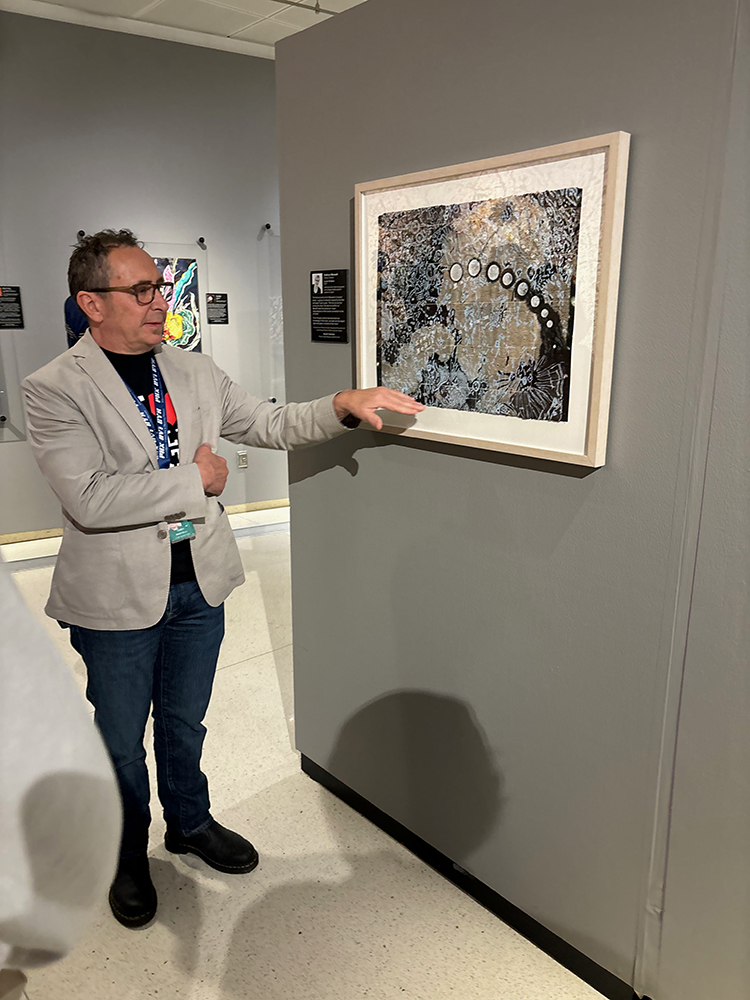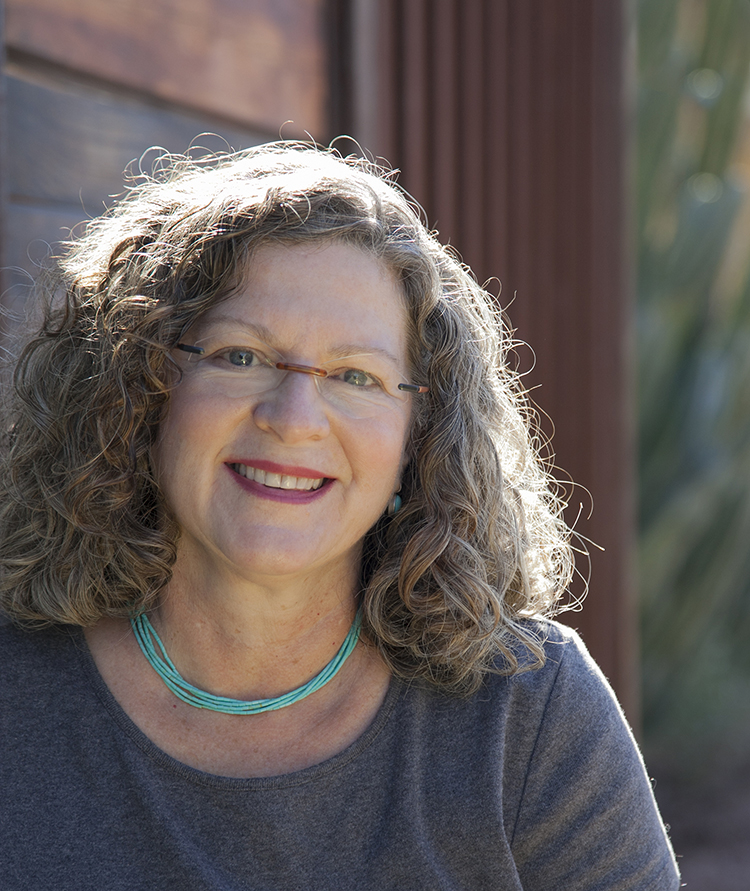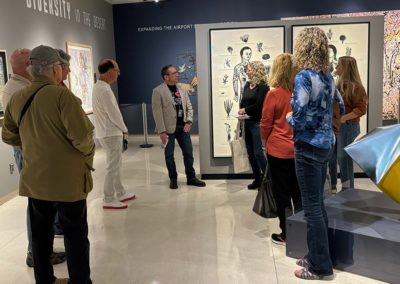Feature Image: Phoenix Airport Museum Curator Gary Martelli and Associate Curator Haley Hinds with AZPA member and artist Rebecca Ross. © Kathy Morgan
On Saturday, March 23, AZPA members had an awesome visit with Gary Martelli, curator, and Haley Hinds, associate curator, of the Phoenix Airport Museum. We met at Phoenix Sky Harbor Airport for a tour of the current Diversity in the Desert and Night Vision exhibits and a thoughtful discussion about airport art and the tasks of creating exhibitions. Gary Martelli and Haley Hinds spoke about the behind-the-scenes work of selecting art and hanging it on the walls while surrounded by thousands of travelers and tourists pushing suitcases, but still enjoying an artistic respite during their journey.

Looking through the front entrance into the Phoenix Airport Museum’s exhibition “Diversity in the Desert.” © Kathy Morgan
We learned that the curators create themed exhibits about every two years. Calls for entries are posted online and by email. The exhibitions often have themes, and the staff is looking for a wide range of art that speaks to the topic in surprising ways. For each submission, the staff requests four images. Considering that more than 400 artists submitted work for the Night Vision exhibition, the airport staff reviewed some 1600 images. They also suggest that artists share work from a single series or group. The curators are looking to see how the works in each submission relate to each other. They warn that if the submissions are from different bodies of work, the submission can seem scattered or unfocused. When submitting, artists should send format submissions to 300 dpi at six inches. This size allows them to use the image in public relations materials. (If an image is too large, they may ask artists to use We Transfer.) All work goes through the website: skyharbor.com/museum
The curators are interested to know about the materials and dimensions. Each submitted image should list the dimensions for the artwork image and also the dimensions of the finished frame size. Name the medium or process used and be specific. Instead of the general phrase “mixed media” use “monoprint with India ink, pencil, ribbons, and gouache.” If an image submitted for consideration is a Polaroid transfer, curators expect to see an actual Polaroid transfer when the artwork is delivered for exhibit. Do not deliver a scanned reproduction of a unique work unless the submission states it is a digital reproduction. Recently the curators decided that photo prints on metal appear too commercial and less like fine art. They warned that in the future they will not be accepting that process.

Curator Gary Martelli gives advice on framing and matting artwork for exhibition. © Kathy Morgan
They are also interested in the framing details and will start requiring a description of the framing during the submission process. For example, one might say the work is an 11×14 image with a white mat that extends three inches around the image. The art is in a 16×20 brushed metal frame, with wires on the back for hanging. That may seem like a lot of detail, but it is invaluable to a curator who is trying to build and sequence an exhibition. They recommend having work professionally framed. If off the shelf frames are submitted, artists should be sure that the proportions of the frame match the image. For example, an 8×10 image in a 12×20 frame can look unbalanced. Frames should be neutral and not distract from the images. Avoid ornate frames unless there is a connection to the image, sticking with black, white, gray metal or wood. Framing styles do change over time and a current trend is white frames. Keep in mind the definition of “ready to hang” from an installer’s perspective. There should be a wire on the back for a wall nail. It is important to remember that sawtooth-style hangers are not acceptable. D-rings are fine but just remember to keep the framing simple, professional.
The curators recommend using white mats and avoiding colored mats. Dimensions should be two to five inches of white mat showing around the image, depending on the size of the image and frame. Do not crowd the image. Ideally, the mat should be equal on top and sides, with a slightly larger bottom dimension. Selecting the image size is crucial. Pick an image size that matches the nature of the image. Intimate work might work best in smaller sizes. Some art might require a large size. Be confident with your choice of image size and do not offer options in multiple sizes. You are the best person to size your art, not the curator.
When preparing an artist statement, one should be clear and concise. Avoid artist jargon. If there is a personal connection to the art, let the curators know. Adding personal data is key. If an artist loves desert hiking and makes work about desert flowers, curators want to know. The curators are looking for insights into the art that a viewer might use to understand and engage with the work. Artists should mention influences. Describe the process and materials if it is unusual or important. Knowing about unusual choices can be interesting to the viewer. For instance, if an artist makes portraits using an 8×10 camera and film, the curators want to know. If a toy Diana camera from the ‘60s is used in order to make dreamlike work, that is important for them to know. If artists are traveling to Arizona ghost towns or making images of the equinox, Gary and Haley want to know. Often, quotes from the artist are included or paraphrased in the wall statement. All of this adds interest for travelers/viewers of the airport exhibitions.
Final notes from the morning tour, the Night Vision exhibition continues until May 26, 2024 in Terminal Four.
AZPA has members who are professional framers, including:
· John Kitts, (422 Fine Framing, 4242 South 37th St., Phoenix, 85040, 602-670-1342)
· Richard Laugharn (Fine Art Framing, 2010 East University Drive, Suite 11, Tempe, 85281, 480-921-8616).
Other framers mentioned during our tour include:
· Brian Ward (Bill’s Custom Frames, 1434 East Williams Street, Tempe, 85282, 480-968-1771)
· Framin’ Works (3119 East Thomas Road, Phoenix, 85016, 602-957-1080).
A few AZPA members use this option for online ordering of metal section frame kits:
· Frame Destination, L.L.C., www.framedestination.com info@framedestination.com 972.479.1188

Rebecca Ross
Contributing Writer
Rebecca Ross is a photographer, educator and public artist. Her photographs have been exhibited nationally and abroad at venues such as the Eye Gallery, San Francisco; Society for Contemporary Photography, Kansas City; and the Canon Photo Gallery, Amsterdam. Ross’s photography is included the permanent collections of the Museum of Fine Arts, Houston; Mayo Clinic, Scottsdale; Harry Ransom Center in Austin, Texas; and the Beinecke Library at Yale University, among others. Awards for her photography include a 2023-24 Research and Development Grant, two Visual Arts Fellowships, and Artist Project Grant from the Arizona Commission on the Arts.
As an art educator, she has worked with diverse groups of people of all ages including college students, K-12 students, Native Americans, and senior citizens. In addition to her photography, Ross has completed more than a dozen public art projects. Her projects have included poetry; ceramics; Morse Code; glass tile; photographs on porcelain-enameled steel, tile, and dyed aluminum; and water features. A longtime collaborator, she has worked with both visual artists and writers.
Her recent work includes botanical photography combined with gold leaf and a long-term series documenting her parents and the experience of caregiving.
Headshot Image Credit © Paul Morris





